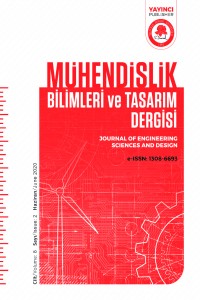Abstract
A standard Least Significant Bit (LSB) algorithm changes average 50% of the least significant bits of an image. This causes approximately a 0.2% distortion on a grayscale image. Therefore, the application of LSB on non-sharp grayscale images causes too much noise that can be easily detected by the human visual system. In addition; when the image is scanned pixel by pixel, hidden message can be easily read by unauthorized persons. A robust and imperceptible block-based LSB steganography method is developed in this study. First, cover image is divided into blocks, then median geometric mean and arithmetic mean of each block is calculated to select blocks those contain less detail of the image. Method has an advantage of calculating data load capacity of image before embedding process. Proposed method also makes it difficult for unauthorized people to detect hidden messages. Performance of the method is measured by mathematical methods such as MSE, PSNR and SSIM. The method achieved structured similarity score over 0.9999% on four test images, indicating a 20-fold better result than the standard LSB algorithm.
References
- Brainos, A., 2004. A Study of steganography and the Art of Hiding Information, Security Writer.
- Chandramouli, R., Memon, N., 2001. Analysis of LSB based image steganography techniques, Proceedings of the International Conference on Image Processing, 3(1), 1019 – 1022.
- Cheddad, A. Condell, J., Curran, K., McKevitt, P., 2010. Digital Image Steganography: Survey and Analysis of Current Methods, Signal Processing, 90(1), 727–752.
- Chopra, D., Gupta, P., Sanjay, G., Gupta, A., 2012. Lsb Based Digital Image Watermarking For Gray Scale Image, IOSR Journal of Computer Engineering, 6(1), 36-41.
- Chore, A.M., Tiwari, N., 2017. Survey on Different Methods of Digital Audio Watermarking, Int. Journal of Engineering Research and Application, 7(6), 113-116.
- Eggers, J.J., Bauml, R., Girod, B., 2002. A Communications Approach to Image Steganography, Proceedings of SPIE, Security and Watermarking of Multimedia Contents IV San Jose, California, USA.
- Hamid, N., Yahya, A., Ahmad, R.B., Al-Qershi, O.M., 2012. Image Steganography Techniques: An Overview, International Journal of Computer Science and Security (IJCSS), 6(1), 3012, 168-187.
- Hamza, Y.A., 2008. Blok Kırpma Kodlamasına ve Ayrık Dalgacık Dönüşümüne Dayalı, Dayanıklı Dijital Renkli Resim Damgalama Sistemi, Anadolu University, Institute of Natural and Applied Sciences, Master Thesis, 92p.
- Jain, N., Meshram, S., Dubey, S., 2012. Image Steganography Using LSB and Edge Detection Technique, International Journal of Soft Computing and Engineering, 2(3), 217-222.
- Johnson, N.F., Jajodia, S., 1998. Exploring Steganography: Seeing the Unseen, IEEE Computer, 26−34.
- Luo, W., Huang, F., Huang, J., 2010. Edge Adaptive Image Steganography Based on LSB Matching Revisited, IEEE Transactions on Information Forensics and Security, 5(2).
- Por, L.Y., Delina, B., 2008. Information Hiding: A New Approach in Text Steganography, 7th WSEAS Int. Conference on Applied Computer & Applied Computational Science (ACACOS '08), Hangzhou, China.
- Swanson, M.D., Zhu, B., Tewfik, A.H., 1996. Transparent robust image watermarking, International Conference on Image Processing, 3(1), 211-214, Laussane, Switzerland.
- Şatır, E., (2013). Bilgi Güvenliği İçin Metin Steganografisinde Yeni Bir Yaklaşım, Selçuk University, Institute of Natural and Applied Sciences, Master Thesis, 82p.
- Yalman, Y., Ertürk, İ., 2009. Gerçek Zamanlı Video Kayıtlarına Veri Gizleme Uygulaması, XI. Academic Informatics Conference Presentations, Harran University, Şanlıurfa, Turkey, 545-552.
- Yu, Y.H., Chang, C.C., Hu, Y.C., 2005. Hiding secret data in images via predictive coding, Pattern Recognition, 38(1), 691–705.
Abstract
References
- Brainos, A., 2004. A Study of steganography and the Art of Hiding Information, Security Writer.
- Chandramouli, R., Memon, N., 2001. Analysis of LSB based image steganography techniques, Proceedings of the International Conference on Image Processing, 3(1), 1019 – 1022.
- Cheddad, A. Condell, J., Curran, K., McKevitt, P., 2010. Digital Image Steganography: Survey and Analysis of Current Methods, Signal Processing, 90(1), 727–752.
- Chopra, D., Gupta, P., Sanjay, G., Gupta, A., 2012. Lsb Based Digital Image Watermarking For Gray Scale Image, IOSR Journal of Computer Engineering, 6(1), 36-41.
- Chore, A.M., Tiwari, N., 2017. Survey on Different Methods of Digital Audio Watermarking, Int. Journal of Engineering Research and Application, 7(6), 113-116.
- Eggers, J.J., Bauml, R., Girod, B., 2002. A Communications Approach to Image Steganography, Proceedings of SPIE, Security and Watermarking of Multimedia Contents IV San Jose, California, USA.
- Hamid, N., Yahya, A., Ahmad, R.B., Al-Qershi, O.M., 2012. Image Steganography Techniques: An Overview, International Journal of Computer Science and Security (IJCSS), 6(1), 3012, 168-187.
- Hamza, Y.A., 2008. Blok Kırpma Kodlamasına ve Ayrık Dalgacık Dönüşümüne Dayalı, Dayanıklı Dijital Renkli Resim Damgalama Sistemi, Anadolu University, Institute of Natural and Applied Sciences, Master Thesis, 92p.
- Jain, N., Meshram, S., Dubey, S., 2012. Image Steganography Using LSB and Edge Detection Technique, International Journal of Soft Computing and Engineering, 2(3), 217-222.
- Johnson, N.F., Jajodia, S., 1998. Exploring Steganography: Seeing the Unseen, IEEE Computer, 26−34.
- Luo, W., Huang, F., Huang, J., 2010. Edge Adaptive Image Steganography Based on LSB Matching Revisited, IEEE Transactions on Information Forensics and Security, 5(2).
- Por, L.Y., Delina, B., 2008. Information Hiding: A New Approach in Text Steganography, 7th WSEAS Int. Conference on Applied Computer & Applied Computational Science (ACACOS '08), Hangzhou, China.
- Swanson, M.D., Zhu, B., Tewfik, A.H., 1996. Transparent robust image watermarking, International Conference on Image Processing, 3(1), 211-214, Laussane, Switzerland.
- Şatır, E., (2013). Bilgi Güvenliği İçin Metin Steganografisinde Yeni Bir Yaklaşım, Selçuk University, Institute of Natural and Applied Sciences, Master Thesis, 82p.
- Yalman, Y., Ertürk, İ., 2009. Gerçek Zamanlı Video Kayıtlarına Veri Gizleme Uygulaması, XI. Academic Informatics Conference Presentations, Harran University, Şanlıurfa, Turkey, 545-552.
- Yu, Y.H., Chang, C.C., Hu, Y.C., 2005. Hiding secret data in images via predictive coding, Pattern Recognition, 38(1), 691–705.
Details
| Primary Language | English |
|---|---|
| Subjects | Computer Software |
| Journal Section | Research Articles |
| Authors | |
| Publication Date | June 25, 2020 |
| Submission Date | March 8, 2019 |
| Acceptance Date | June 2, 2020 |
| Published in Issue | Year 2020 Volume: 8 Issue: 2 |


